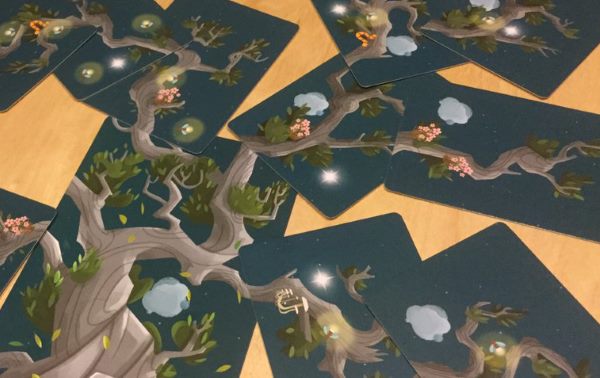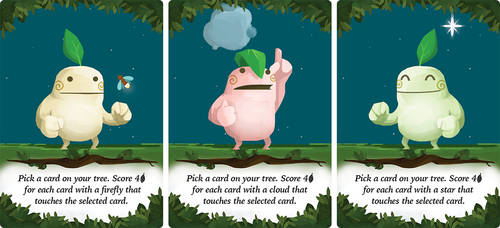
Who’d have thought you’d be able to make a game out of growing trees? It certainly sounds like a tall order, but after a couple of games of Kodama it quickly becomes apparent that not only can you make a successful game out of it, but also one which forces you to make crucial decisions at crucial times which can make or break your end result. It’s cute, it’s beautiful to look at, but there’s a sharp edge to Kodama which demands your attention.
Played over three seasons (most trees don’t really grow much in winter so they left it out) each player will need to grow their tree by adding cards to their starting trunk. For each season there are three phases of play: the Decree phase which sets a randomly selected rule for everyone to follow for that season, the Growing phase which gives each player four chances to grow their tree, and the Kodama phase lets you use one of your four Kodama cards (also randomly assigned at the start of the game). Once these phases have been completed for all three seasons then whoever has the most points wins. As rules go they don’t get much simpler.
As winning strategies go however, this is a little tricker to nail.

The moments which carry the most challenge are the growing phases, those moments when you can pick from one of the face up branch cards and add them to your own tree. The complication lies in the scoring – when you place a new branch on your tree it’ll have something on it, maybe some fireflies or a flower. You score points by following that branch down towards the trunk, counting how many of each you have in a direct line back to the base card. Any cards in the line without said features stop your score in its tracks, and as such you want to be trying to expand your tree with as many adjoining features as possible.
So far so straightforward, so why isn’t this just a case of matching up the same cards? Part of the issue is that there’s a score limit of 10 points on any run of cards, so once you hit that point you’ve got to start looking elsewhere. But if you’ve been focusing all of your attention on a single branch up until this point, you might’ve missed out on some opportunities to expand in other areas. So when do you quite literally branch off in other directions, and when do you get as many points as possible in the short term, leading to a longer term shortfall? It depends on a few factors; your Kodama cards, the decree card currently in play, as well as any patterns you see in your opponents’ game that you might want to try and block, easier said than done considering you don’t know what their individual bonuses are and exactly what their gameplan is.

This extra layer of strategy is quite nicely hidden beneath some of the cutest components I’ve seen for a long time. From the cuddly looking Kodama themselves, through to the tiniest of details on the trees such as the caterpillars, stars or other elements, the whole package looks fantastic. As such it’s quite a nice game to play with younger gamers if you’re happy to tone down your own ambitions, with kids from 6 or 7 upwards probably having a good chance of grasping the key concepts of the game, even if the long term strategy doesn’t come into play.
Kodama, then, is one of those great games that is easy to learn and enjoyable to play. There’s no need to have a PhD to understand the rules, but go into a competitive game against some like minded players and you can expect a pretty tough battle to be the tree-god that you’ve always wanted to be. If you see the box and feel a pang of temptation, don’t fight it. You won’t regret it.
Kodama
Available Now, RRP £19.99
Find your local stockist here

Leave a Reply